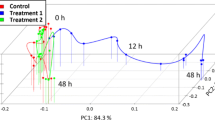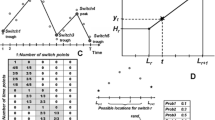Abstract
The study of complex biological processes requires to forgo simplified models for extensive ones. Yet, these models’ size and complexity place them beyond understanding. Their analysis requires new methods for identifying general patterns. The Transforming Growth Factor TGF-\(\beta \) is a multifunctional cytokine that regulates mammalian cell development, differentiation, and homeostasis. Depending on the context, it can play the antagonistic roles of growth inhibitor or of tumor promoter. Its context-dependent pleiotropic nature is associated with complex signaling pathways. The most comprehensive model of TGF-\(\beta \)-dependent signaling is composed of 15,934 chains of reactions (trajectories) linking TGF-\(\beta \) to at least one of its 159 target genes. Identifying functional patterns in such a network requires new automated methods.
This article presents a framework for identifying groups of similar trajectories composed of the same molecules using an exhaustive and without prior assumptions approach. First, the trajectories were clustered using the Relevant Set Correlation model, a shared nearest-neighbors clustering method. Five groups of trajectories were identified. Second, for each cluster the over-represented molecules were determined by scoring the frequency of each molecule implicated in trajectories. Third, Gene set enrichment analysis on the clusters of trajectories revealed some specific TGF-\(\beta \)-dependent biological processes, with different clusters associated to the antagonists roles of TGF-\(\beta \). This confirms that our approach yields biologically-relevant results. We developed a web interface that facilitates graph visualization and analysis.
Our clustering-based method is suitable for identifying families of functionally-similar trajectories in the TGF-\(\beta \) signaling network. It can be generalized to explore any large-scale biological pathways.
Access this chapter
Tax calculation will be finalised at checkout
Purchases are for personal use only
Similar content being viewed by others
References
Aldridge, B.B., Burke, J.M., Lauffenburger, D.A., Sorger, P.K.: Physicochemical modelling of cell signalling pathways. Nat. Cell Biol. 8(11), 1195–1203 (2006)
Andrieux, G., Le Borgne, M., Théret, N.: An integrative modeling framework reveals plasticity of TGF-\(\beta \) signaling. BMC Syst. Biol. 8(1), 1 (2014)
Bierie, B., Moses, H.L.: Tumour microenvironment: TGF\(\beta \): the molecular Jekyll and Hyde of cancer. Nat. Rev. Cancer 6(7), 506–520 (2006)
ElKalaawy, N., Wassal, A.: Methodologies for the modeling and simulation of biochemical networks, illustrated for signal transduction pathways: a primer. Biosystems 129, 1–18 (2015)
Hamzaoui, A., Joly, A., Boujemaa, N.: Multi-source shared nearest neighbours for multi-modal image clustering. Multimedia Tools Appl. 51(2), 479–503 (2011)
Houle, M.E.: The relevant-set correlation model for data clustering. Stat. Anal. Data Min. 1(3), 157–176 (2008)
Ikushima, H., Miyazono, K.: Biology of transforming growth factor-\(\beta \) signaling. Curr. Pharm. Biotechnol. 12(12), 2099–2107 (2011)
Joshi, A., Kaur, R.: A review: comparative study of various clustering techniques in data mining. Int. J. Adv. Res. Comput. Sci. Softw. Eng. 3(3) (2013)
Kashtan, N., Alon, U.: Spontaneous evolution of modularity and network motifs. Proc. Natl. Acad. Sci. U.S.A. 102(39), 13773–13778 (2005)
Kestler, H.A., Wawra, C., Kracher, B., Kühl, M.: Network modeling of signal transduction: establishing the global view. BioEssays 30(11–12), 1110–1125 (2008)
Lim, W.A.: Designing customized cell signalling circuits. Nat. Rev. Mol. Cell Biol. 11(6), 393–403 (2010)
Luo, K.: Signaling cross talk between TGF-\(\beta \)/Smad and other signaling pathways. Cold Spring Harbor Perspect. Biol. 9(1), a022137 (2017)
Massagué, J.: TGF\(\beta \) signalling in context. Nat. Rev. Mol. Cell Biol. 13(10), 616–630 (2012)
Mu, Y., Gudey, S.K., Landström, M.: Non-smad signaling pathways. Cell Tissue Res. 347(1), 11–20 (2012)
Peisajovich, S.G., Garbarino, J.E., Wei, P., Lim, W.A.: Rapid diversification of cell signaling phenotypes by modular domain recombination. Science 328(5976), 368–372 (2010)
Rauzy, A.: Guarded transition systems: a new states/events formalism for reliability studies. Proc. Inst. Mech. Eng. Part O: J. Risk Reliab. 222(4), 495–505 (2008)
Saadatpour, A., Albert, R.: Discrete dynamic modeling of signal transduction networks. In: Liu, X., Betterton, M.D. (eds.) Computational Modeling of Signaling Networks, pp. 255–272. Humana Press, Totowa (2012)
Saadatpour, A., Albert, R., Reluga, T.C.: A reduction method for boolean network models proven to conserve attractors. SIAM J. Appl. Dyn. Syst. 12(4), 1997–2011 (2013)
Samaga, R., Klamt, S.: Modeling approaches for qualitative and semi-quantitative analysis of cellular signaling networks. Cell Commun. Signal. 11(1), 1 (2013)
Schaefer, C.F., Anthony, K., Krupa, S., Buchoff, J., Day, M., Hannay, T., Buetow, K.H.: PID: the pathway interaction database. Nucleic Acids Res. 37(suppl 1), D674–D679 (2009)
Scott, J.D., Pawson, T.: Cell signaling in space and time: where proteins come together and when they’re apart. Science 326(5957), 1220–1224 (2009)
Subramanian, A., Tamayo, P., Mootha, V.K., Mukherjee, S., Ebert, B.L., Gillette, M.A., Paulovich, A., Pomeroy, S.L., Golub, T.R., Lander, E.S., et al.: Gene set enrichment analysis: a knowledge-based approach for interpreting genome-wide expression profiles. Proc. Natl. Acad. Sci. 102(43), 15545–15550 (2005)
Supek, F., Bošnjak, M., Škunca, N., Šmuc, T.: Revigo summarizes and visualizes long lists of gene ontology terms. PLoS ONE 6(7), e21800 (2011)
Tian, M., Neil, J.R., Schiemann, W.P.: Transforming growth factor-\(\beta \) and the hallmarks of cancer. Cell. Signal. 23(6), 951–962 (2011)
Zañudo, J.G., Albert, R.: An effective network reduction approach to find the dynamical repertoire of discrete dynamic networks. Chaos Interdisc. J. Nonlinear Sci. 23(2), 025111 (2013)
Zhao, Y., Kim, J., Filippone, M.: Aggregation algorithm towards large-scale boolean network analysis. IEEE Trans. Autom. Control 58(8), 1976–1985 (2013)
Zi, Z., Chapnick, D.A., Liu, X.: Dynamics of TGF-\(\beta \)/Smad signaling. FEBS Lett. 586(14), 1921–1928 (2012)
Author information
Authors and Affiliations
Corresponding author
Editor information
Editors and Affiliations
Rights and permissions
Copyright information
© 2017 Springer International Publishing AG
About this paper
Cite this paper
Coquet, J., Theret, N., Legagneux, V., Dameron, O. (2017). Identifying Functional Families of Trajectories in Biological Pathways by Soft Clustering: Application to TGF-\(\beta \) Signaling. In: Feret, J., Koeppl, H. (eds) Computational Methods in Systems Biology. CMSB 2017. Lecture Notes in Computer Science(), vol 10545. Springer, Cham. https://doi.org/10.1007/978-3-319-67471-1_6
Download citation
DOI: https://doi.org/10.1007/978-3-319-67471-1_6
Published:
Publisher Name: Springer, Cham
Print ISBN: 978-3-319-67470-4
Online ISBN: 978-3-319-67471-1
eBook Packages: Computer ScienceComputer Science (R0)




